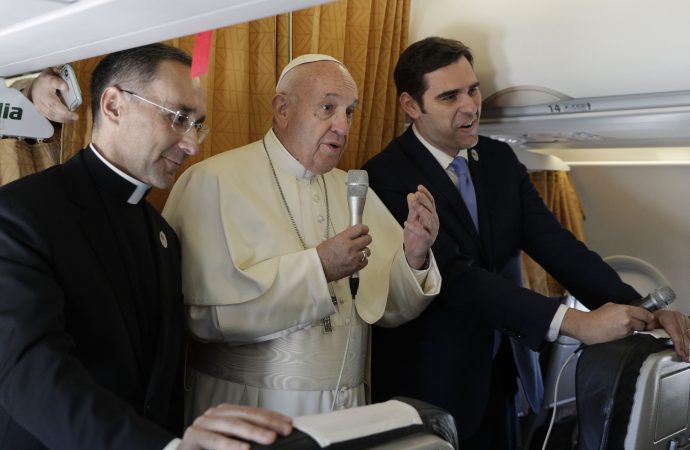Having just returned from an 18-day swing through the U.S. that took us to Boston, Denver, South Bend, Anaheim, Simi Valley, Whittier and Detroit, here’s probably the most common question I got along the way from American Catholics vis-à-vis the home office in Rome: “Do those guys over there get it?”
The “it” refers to the clerical sexual abuse crisis, and, more specifically, the gravity and depth of the situation as experienced by American Catholics over the last several months, and thus the perceived need for urgent and dramatic action.
Obviously, it would have been great if my answer could have been, “Yeah, absolutely, of course.” That would have been reassuring to the people we met, and also would have made the lives of the pastors, parish ministers and bishops we encountered infinitely easier.
Alas, recent experience dictates a more complicated response. To grasp why, let’s consider developments in just the last few days.
To begin, last week a Vatican-backed investigation commenced in the Argentine diocese of Oran regarding accusations of both sexual and financial misconduct against its former shepherd, Bishop Gustavo Zanchetta, who’s now the number two official in the Vatican’s Administration of the Patrimony of the Apostolic See, meaning its main financial administration center.
Archbishop Carlos Alberto Sánchez of neighboring Tucumán has been assigned to conduct the probe, which apparently will involve interviewing seminarians who’ve claimed to be victims of abuse by Zanchetta.
While taking such complaints seriously is obviously a welcome move, critics have asked why it’s taken so long given that charges against Zanchetta arose in 2015. In turn, that’s led people to wonder why Pope Francis brought Zanchetta to Rome in the first place in 2017 - and why, for that matter, he invited Zanchetta to take part in the annual Lenten retreat for Vatican personnel just a couple of weeks ago.
Last Saturday, Pope Francis accepted the resignation of Cardinal Riccardo Ezzati of Santiago, Chile, who’s facing charges of having covered up for that country’s most notorious pedophile priest, Fernando Karadima, and who’s also recently been named in a $500,000 lawsuit related to a rape that allegedly took place in a bedroom of the residence at his cathedral in 2015 that Ezzati reportedly tried to keep quiet.
Chile has been devastated by arguably the worst clerical abuse scandal anywhere in the world over the last several years, so Ezzati’s resignation had been keenly anticipated. Though Francis did not name a successor, he appointed an apostolic administrator in the meantime: Capuchin Bishop Celestino Aós Braco, who was formerly a promoter of justice in the diocese of Valparaiso and has faced criticism for dismissing abuse complaints brought by ex-seminarians against five priests, one of whom is now dead and the others are facing investigations.
In all fairness, some abuse survivors in Chile have been willing to give Aós the benefit of the doubt for his role in Valparaiso, noting that as a simple priest at the time it wasn’t his role to set policy. That was the function of now-resigned Bishop Gonzalo Duarte, who’s been accused of covering up abuse cases.
That brings us to new anti-abuse guidelines issued by Pope Francis on Friday for the Vatican City State and the Vatican’s foreign missions abroad, such as the papal embassy in Washington, D.C., and the other capitals of the world.
(As a technical matter, the Vatican released three new documents in the roll-out Friday - the guidelines themselves, said to reflect “best practices” in anti-abuse efforts; a new law for the Vatican City State; and a motu proprioapplying the same norms to the Roman Curia, meaning the governing bureaucracy of the Church in Rome.)
Among other things, the rules require officials to report accusations of the sexual abuse of a minor immediately to prosecutors - in this case, since the focus is on crimes committed on Vatican territory, the report would be to Vatican prosecutors.
The real question about Friday’s announcement is why it took so long to get there, given that the Vatican ordered bishops’ conferences around the world to draft these sorts of guidelines in 2011. Since that moment it’s been irritating to many people that the Vatican was insisting local churches move swiftly to draft and implement policies it hadn’t imposed on itself, and why it took eight years to plug that hole is something of a mystery.
In principle, each of these three developments could be spun as a good news story.
On Zanchetta, Francis has authorized an investigation of a friend and a bishop from his home country; in Chile, the premier public symbol of the country’s crisis has been removed, creating the possibility of a new departure; and as far as the Vatican goes, it’s now bound by the same state-of-the-art protocols adopted by the Church in parts of the world such as the U.S. and Western Europe.
The difficulty with such an optimistic spin, however, is that each of these three developments is ambivalent.
With Zanchetta, the key question is how much Francis knew when he brought him to Rome two years ago, followed closely by why he hasn’t been suspended now pending investigation. In Santiago, it’s legitimate to wonder about the sensitivity of picking an interim leader for such a traumatized place with his own troubled history. On the guidelines, well, nobody’s yet explained why in the world it took this long.
In other words, Francis can occasionally make it challenging to sell people on the idea that the Vatican really “gets it” - and his window to close that sale may not remain open much longer.

